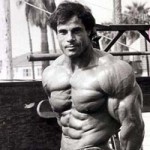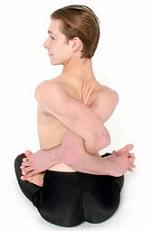 Franco Columbo |
Inexperienced athletes do dumb things. Most people look for the easiest way from point A to point B, and sometimes they become obsessed with trivial details. I did it; you did it… or maybe you still do it; and the newbie that jumps on the bench after you will do it too.
Hell, when I first started training, I was following a 6 day per week, 2 a day program, written by some professional bodybuilder. It took me a year to learn how to do barbell back squats and even longer to start deadlifting. I thought I knew what I was doing just like you do.
In order to take that first step towards knowing everything, we must first realize that we know nothing. This is what I want you to do before you read the rest of this article. Once you can admit that you know nothing about weightlifting, you can read these tips and apply them to what you have been doing, in order to start doing what you should be doing.
Once you have the proper train of thought, you may proceed…
- You don’t really know WHY you are training.
Are you an athlete in a specific sport? Are you a bodybuilder? Perhaps a mixed martial artist? Or maybe you’ve got your sites set on finishing your first triathlon?
If you are like most of us when we started training, all you really want to do is look good naked.
Either way, you need to figure out your goals, which might fall under one of the following categories.
- Sport Specific Performance
- Powerlifting
- Strongman Training
- Lose Fat and Maintain Muscle
- Gain Muscle and Maintain Bodyfat
- Endurance Training
Whatever your answer is, it can’t be wrong. Your goals are your goals, but you need to decide for yourself what they are. People waste years trying to accomplish everything at the same time, or having no idea what they really want to accomplish. Don’t be that person.
Your task: Decide what your ultimate goal is, find a program that fits it, and don’t stop until you’ve reached your goal.
- You don’t warm up.
This is an easy mistake to fix. If you roll up into the gym all cold and stiff, and just start lifting away, you are setting yourself up for poor performance and possibly injury.
Before you start an intense workout, you should definitely test out the muscles you plan to work that day, with light weights. This way you will be able to identify any muscle group that has potential for injury, or is perhaps not fully recovered from a previous workout. You want to fill those muscles up with blood so they can prepare for the beating you are about to hand out.
Your task: Start every workout with a 10 minute, full body warm up. I recommend 5 minutes on the elliptical and another 5 minutes lifting light weights just to test your body for injury or weakness before you begin the real routine.
- You haven’t built a solid base before moving on to advanced training.
Before you can build a house, you have to lay the foundation. This same rule applied to training. Every trainee should start with a 3 day per week, full body training program, focusing on compound movements and perfect form, for at least 12 weeks.
Each day you should have a main lift consisting of:
- Deadlift variation
- Squat variation
- Bench press variation
- Overhead press
- Pull up variation
- Row variation
None of these exercises should be performed with anything other than free weights, and you should not be sitting down for any of them. You may, however, lie down when benching. =D
Then add in 3-4 more accessory exercises to complete the full body training. You should be hitting legs, chest, back, shoulders, triceps, and abs each day. Direct bicep training is optional and must not be focused on, no matter how badly you want those guns. Remember, your triceps make up 2/3 of your arm.
Please split your training into 3, 4 week phases. Periodize your training so that you are lifting lighter weights for 10-12 reps for 4 weeks. Then move to a hypertrophy/strength phase by using 7-10 rep sets. Finally focus on strength by using 5 rep sets on the core exercises and 7 rep sets on the accessory work.
Your task: Find a full body workout program that you can stick to for a minimum of 12 weeks. Periodize it. Then stick to it for 12 weeks. Report back when finished.
- Too much focus on flexibility and functionality.

Flexible ManFirst off, if you are focusing too much on flexibility, you could be jeopardizing your strength gains. Weight training with an excessive range of motion will both limit your potential for strength and put you at risk for injury.
If you are constantly training on workout balls or bosu balls or other unstable surfaces, you are probably also using weights that are far too light. You won’t ever need to be able to balance on one leg, on a plastic bubble, during an earthquake, with 10 lbs in each hand raised above your head, and added weight on your free leg.
Don’t waste your time by emphasizing these things. Compound unilateral exercises such as one leg squats, a small variety of weighted functional exercises like Turkish get-ups, and some Olympic training with cleans and snatches will give you all the functional training you need. Do compound functional exercises and avoid doing any moves that require you to stand on equipment inflated with air.
You should also stretch thoroughly after each workout and address legitimate muscle imbalances when necessary. Just don’t obsess over it.
Your task: If you focus too much on non-existent weak spots, if you dedicate too much time to stability and mobility, and if you avoid the heavier weights because you don’t think you are stable or flexible enough, stop it now. Convert your focus to building your core strength through a full-body periodized workout routine.
- You think you know what you need to do, but you are wrong.
Is this you?
- You want big guns so you do 45 minute bicep workouts.
- You want a big chest so every day is bench day.
- You don’t train legs.
- You sit down or use machines for every exercise.
If this is you, I am going to teach you 4 important lessons right now:
- small muscle groups do not grow much independently of large muscle groups
- large muscle groups do not grow much independently of other large muscle groups
- muscles grow slower when you are sitting down all the time
- muscles grow faster when you are using exercises that translate directly into sport performance
For lesson 1, if you want big biceps you need to train the muscle for which the biceps act as ancillary movers, e.g. back. Same thing applies to chest and triceps, and calves and quads/hams.
For lesson 2, if you only focus on chest, you will develop muscular imbalances everywhere else including your shoulders and back. This will inevitably lead to injury, plus you will look goofy. This same rule applies to neglecting your legs. Similarly, you won’t have an extraordinary bench if you don’t work your triceps.
For lesson 3, you sit at your desk, you sit in the car, you sit in front of the TV… do you also sit down at the gym? If so, stand up. 95% of exercises should be performed standing up in order to faciliate full body muscle fiber recruitment.
For lesson 4, anything that moves your body through space, on a solid surface, in a variable plane, while requiring balance is better than a static machine. The leg press is goofy compared to a barbell squat. Any smith machine exercise is far less effective than if you take that bar OFF the machine. Using a smith machine is akin to bowling with those long ass snakes in the gutters that we usually use to boost the confidence of little kids that repeatedly throw gutter balls.
Your task: Balance pushing and pulling movements. Train your back to grow your bis. Train your chest to grow your tris. Train your legs to grow your upper body. Train your abs to grow your legs. See what I’m getting at here? You still need to train your whole body in order to target a specific muscle group for development, and compound exercises are always better.
- You never increase your intensity.
This applies to shorter rest periods, increased reps, and most importantly, heavier weights.
Your body looks the way it does today, because you do what you’ve been doing. Now if you want it to be stronger, harder, or leaner, you will need to force it to adapt to increased stimulus.
The best ways to do this:
- add weight
- try more challenging exercise variations
- use shorter rest periods between sets
- add a set
- add reps
Your task: You don’t need to train until you vomit, but you should be putting everything you have into each work set. At each workout session you should strive to do something better than you did the previous workout.
- Cardiovascular exercise puts you to sleep.
Listen, steady-state endurance type cardio is boring. But the good news is, it’s probably not all that effective for you anyway, so you should probably just avoid it altogether.
I’m just guessing here, but if you are trying to do cardio you are probably overweight. This fact alone tells us that you are probably not an ectomorph, and therefore your body doesn’t adapt to endurance type exercise anyway. You need to focus on something with more intensity.
I recommend the following alternatives to endurance cardio:
- Interval sprints on a bike.
- Interval sprints running.
- Hill sprints.
- Stair sprints.
- Running sprints with a weighted vest.
- Circuit training with dumbbells, kettle bells, and bodyweight.
One final recommendation: Save your cardio workouts until well after or way before your weightlifting workouts. By lifting weights with high intensity and then doing an hour of cardio, you are just sabotaging your own recovery by further breaking down muscle tissue, using up precious recovery calories, and increasing cortisol. After your weightlifting just drink your post-workout shake and relax.
Your task: Have fun with your cardio and try to find a secondary purpose behind it. Take a kickboxing class, learn jujitsu, start sprinting, play racquetball, or anything else that combines fun with high intensity exercise.
- Your posture is bunk because you sit all the time.
I just want to draw some additional attention to this problem. Realistically, exercise should be done standing up. Do you think cavemen sat down when they hunted buffalo? Do you think Davey Crocket was sitting when he killed that bear when he was only 3? The origins of physical fitness stem from being active… running, jumping, hunting, throwing, pulling, and dragging. This is what you should do too.
If all you do is sit down, you probably have tight pecs from slouching and tight hip flexors from… well… sitting. These conditions will function to facilitate injury and they definitely do nothing to help you look good naked.
Any muscle can be trained from a standing position. Granted, some exercise require us to lay on a bench, but the idea is that if your upper body is perpendicular to the floor during exercise, you should probably be standing.
Your task: Implement and adhere to a no-sitting rule while you exercise. It’s OK to lay down for certain movements, but if your body is upright you should be standing on your feet. Also remember to stretch after every workout, especially your pecs, hips, and hip flexors.
- You think women are attracted to disproportional physiques.

Bikini GirlThe reality of that statement is that women think small legs on a guy are hilarious… in a turned-off kinda way. Seriously. Guy that focus on chest and biceps are in for a big surprise. Since you are only half developed, don’t expect a fully developed girl to be attracted to you.
You see that girl over there who has buff arms from working out, but a bit of a beer belly from eating or drinking too much? Yeah, that girl is made for you buddy.
Women also think guys that walk around with their arms all propped out are goofy too. If you have imaginary lat syndrome, you need to start doing pull ups and free weight rows. What makes you think girls are into egotistical fools that think they are bigger and stronger than they really are?
See that girl over there who’s wearing a super tight shirt but has no cleavage but looks like a stuffed sausage? There’s your match Mr. Ego.
Your task: Train your whole body. If you are focusing on a certain muscle group such as your chest, you better balance it out with a couple months of focusing on legs and back too.
- You attempt to lift way more than you should.
I know you want to bench 1200 lbs today. You are striving and striving to deadlift 2000 lbs and won’t take ‘NO’ for an answer. No matter how strong you really are, you will lift way more than what you are capable of. And how will you pull this off? By sacrificing form.
There is an amount of cheating that is acceptable. A little swing here, a little bounce there, maybe you take advantage of the stretch reflex action once in a while. No harm, no foul.
The problems start to happen when you compromise the structural integrity of your body.
Some examples are:
- Lifting with your back rather than your legs.
- Over arching your back when benching.
- Hyper extending your vertebrae while trying to curl.
- Bouncing the bar off your chest while benching.
- Turning every set of standing military presses into push presses.
- Uneven and awkward handling of too-heavy dumbbells.
- Stopping short of a full range of motion while performing a full range of motion exercise.
Your task: Learn the correct form for every exercise you perform. Do NOT lift heavier loads than you can handle at the expense of proper form.
- Your don’t push yourself to lift heavy loads.
Think back to your last year of lifting. Have you focused on sets of 8 or sets of 10 for the most part? Do you stick to 3×5 or 5×5 workout plans? If so, you will never reach your full potential.
At some point in time you will have to ‘max out’ if you want to make REAL strength gains. I’m talking about sets of 1-3 reps with 90+% of your 1 rep max.
I’m not saying you have to go out and start doing forced reps and super-slow negatives, I’m just saying you should test your max once in a while, and maybe even work in a strength phase for a couple months each year.
Personally, when I was training in college I probably went 6 months at a time without doing more than 5 reps for anything. The exceptions being shrugs, calves, and the one set of dumbbell curls I did each month.
Even now as I try to make my comeback, I will lift in the 7-10 rep range for about 2 weeks before moving down to 5 rep sets. This is what makes me grow bigger and stronger… well mostly stronger. To get bigger I usually have to focus on sets of 8-10.
Even when I create workout routines for others, I have them start at 10-12 reps and work their way down to 5 rep sets within 10 weeks. Add 5 reps to both numbers for women. I will occasionally have a female train in the 5 rep range if the situation calls for it.
Your task: Max out on bench press, squats, and deadlifts. Then train heavy for 2 months, adding weight each week, and retest your 1 rm after the strength phase. Oh, did every muscle in your body also get bigger? Hm. Imagine that. Also see the previous bullet about lifting with proper form.
- You don’t take advice from experts.
Find someone who has what you want, and ask them how they got it. Also, seriously consider the advice of experienced lifters in the gym.
A strong guy might offer a tip to increase your squats or deads, so what will you do? If you are like most young punks you will brush it off and continue to do things your way because you know everything. However, if you can be humble and understand that just maybe some folks know more and better information about training than you, you just might break your plateau next week.
Remember, some philosophers say, “To know everything is to know nothing, but to know nothing is to know everything.” Or if you prefer I can put it another way, “He who knows that he knows nothing, knows everything.” The idea is that once you can commit to learning at all costs, you will thrive. As long as you stay a stubborn pig-headed know-it-all, you will only survive.
Your task: Not only should you ask for advice from those who are better than you at what you want to do, but you should also generously offer advice to newbies, but ONLY if you know what you are doing. You are not an expert if you’ve been training for 1 year, but you might have something to offer to someone who’s only been training for a week. Be nice and offer some guidance… be proud of them for trying.
This is by no means a complete list. We all make mistakes on a daily basis. Some small, some large. But maybe… just maybe… one of these mistakes clicked with you and changed your whole philosophy on lifting. Or maybe you’ll just stop curling in the squat rack. Either way, everyone wins.
Tags: athletes, Conditioning, mistakes, Weight Training, weightlifting











The best all around exercise is running. I think for upper body fitness, pull-ups are hard to beat.
HTS: Endurance running is horrible. It destroys your ankles, knees, hips, and spine, as well as taking a toll on the rest of your body. Even if you run on a soft surface it will wear on the joints in your lower body after a while. However, high intensity interval training (HIIT) is great. The frequency and duration are much lower, so your body takes less of a beating, and it works better for both fat loss and muscle gain.
I do have to agree that pull-ups are great!
Do you think Davey Crocket was sitting when he killed that bear when he was only 3? lol
Interesting. Good post including phsychological reasons as well.
Great Article!
I appreaciate the amount of information included. You came up with a very comprehensive list that is a must-read for people that are jumping into their workouts without a plan.